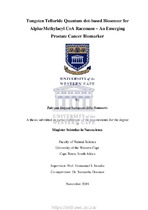| dc.contributor.advisor | Iwuoha, Emmanuel | |
| dc.contributor.author | Sampson, Zaiyaan Begum | |
| dc.date.accessioned | 2020-12-09T09:10:55Z | |
| dc.date.available | 2020-12-09T09:10:55Z | |
| dc.date.issued | 2019 | |
| dc.identifier.uri | http://hdl.handle.net/11394/7709 | |
| dc.description | >Magister Scientiae - MSc | en_US |
| dc.description.abstract | Prostate cancer, commonly referred to as adenocarcinoma of the prostate, is the leading cause of cancer death in men in 46 countries, and it was estimated that by the end of 2018 there would approximately be 1.3 million new cases of prostate cancer worldwide. Currently, the Food and Drug Administration (FDA) approved biomarker for prostate cancer disease diagnostics Prostate Specific Antigen (PSA) is not specific to the disease itself but extends to other cases such as Benign Prostate Hyperplasia (BPH) a condition in which the prostate grows uncontrollably. This biomarker is then detected in blood samples via conventional methods which require a qualified individual to operate and are often time consuming. Examples of these methods are spectrophotometry and High Performance Liquid Chromatography (HPLC). Hence, a more efficient biomarker and method of detection is needed for prostate cancer disease diagnostics, as early detection of the disease means early treatment, which could ultimately save lives. Currently, an emerging biomarker for prostate cancer known as Alpha-Methyl CoA Racemase (AMACR) has shown to be more specific to the disease with advantages such as being a non-invasive biomarker. AMACR has been reported to be present in urine, and thus may be detected via a non-invasive method. This study proposed an economical, non-invasive electrochemical biosensor for the rapid detection of AMACR based on mercaptosuccinic acid capped tungsten telluride (MSA-WTe3) quantum dots (QDs). Nanomaterial has shown promise in terms of increasing the sensitivity and specificity of sensors. MSA-WTe3 QDs was successfully synthesized using easy, inexpensive method and was studied by various techniques such as High Resolution Transmission Electron Microscopy (HR-TEM) where the size was confirmed to be within the nanometer scale and was reported to be 2.65 nm with a good crystallinity. X-ray diffraction (XRD) confirmed the structural properties and chemical composition of the QDs and it is reported that the QDs are rich in both tellurium and tungsten and comprise of a hexagonal structure. Scanning Electron Microscopy (SEM) confirmed the successful immobilization of aptamer sequence specific to AMACR onto the electrode surface by showing a distinct conformational change when aptamers were introduced to the QDs under study. This study reports the successful detection of AMACR using an MSA-WTe3 QDs based aptasensor immobilized onto a screen printed glassy carbon electrode, with a detection limit of 0.35651 ng/mL and a limit of quantification calculated to be 1.08033 ng/mL. | en_US |
| dc.language.iso | en | en_US |
| dc.publisher | University of the Western Cape | en_US |
| dc.subject | Prostate Cancer | en_US |
| dc.subject | Aptamer | en_US |
| dc.subject | AMACR | en_US |
| dc.subject | Quantum Dots | en_US |
| dc.subject | Mercaptosuccinic Acid | en_US |
| dc.subject | Tungsten Telluride | en_US |
| dc.subject | Biomarker | en_US |
| dc.subject | Diagnostics | en_US |
| dc.subject | Biosensor | en_US |
| dc.subject | Aptasensor | en_US |
| dc.subject | Electrochemical Impedance Spectroscopy | en_US |
| dc.subject | Differential Pulse Voltammetry | en_US |
| dc.subject | Microwave Synthesis | en_US |
| dc.title | Tungsten Telluride Quantum dot-based Biosensor for Alpha-Methylacyl CoA Racemase – An Emerging Prostate Cancer Biomarker | en_US |
| dc.rights.holder | University of the Western Cape | en_US |

